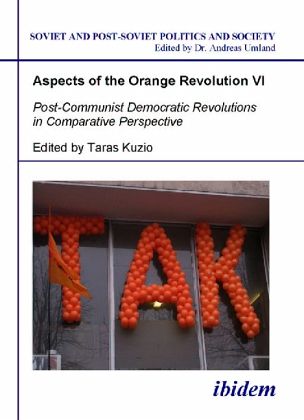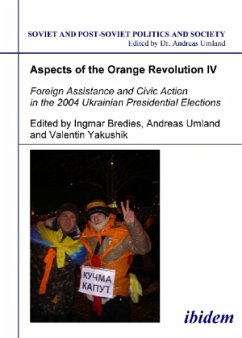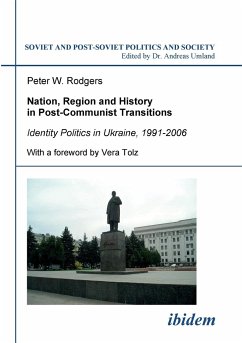
Aspects of the Orange Revolution VI - Post-Communist Democratic Revolutions in Comparative Perspective / Aspects of the Orange Revolution 6
Versandkostenfrei!
Versandfertig in 6-10 Tagen
34,90 €
inkl. MwSt.

PAYBACK Punkte
0 °P sammeln!
Post-communist democratic revolutions have, so far, taken place in six countries: Slovakia (1998), Croatia (1999 - 2000), Serbia (2000), Georgia (2003), Ukraine (2004) and Kyrgyzstan (2005). The seven chapters in this volume situate these events within a theoretical and comparative perspective. The volume draws upon extensive experience and field research conducted by political scientists specializing in comparative democratization, regime politics, political transitions, electoral studies, and the post-communist world. The papers by Valerie Bunce and Sharon Wolchik, Henry Hale, Paul D Anieri,...
Post-communist democratic revolutions have, so far, taken place in six countries: Slovakia (1998), Croatia (1999 - 2000), Serbia (2000), Georgia (2003), Ukraine (2004) and Kyrgyzstan (2005). The seven chapters in this volume situate these events within a theoretical and comparative perspective. The volume draws upon extensive experience and field research conducted by political scientists specializing in comparative democratization, regime politics, political transitions, electoral studies, and the post-communist world. The papers by Valerie Bunce and Sharon Wolchik, Henry Hale, Paul D Anieri, David R. Marples, Taras Kuzio, Lucan A. Way and Steven Levitsky, as well as Anika Locke Binnendijk and Ivan Marovic explore different regime types and opposition strategies in post-communist states, the diffusion of opposition strategies between states in which democratic revolutions were attempted, the strategic importance of youth NGO s in mobilizing oppositions towards democratic revolutions, the use of non-violent strategies by the opposition, path dependent, theoretical and comparative explanations of the sources of successful and failed democratic revolutions, and the factors that lie behind divergent post-revolutionary trajectories.
The volume represents a breakthrough in our understanding of why and how democratic revolutions take place in the post-communist world. It provides an integrated analysis of why such upheavals succeed in some, but fail in other states. The contributions point to, among other issues, why the post-revolutionary breakthroughs in Serbia, Ukraine and Kyrgyzstan have encountered obstacles, the ousted regime was never fully defeated and its representatives were able to launch counter-revolutions, as well as why, in Serbia and Ukraine, the political forces of the ousted regimes have returned to power in free elections held after democratic revolutions.
Post-Communist Democratic Revolutions in Comparative Perspective will be important reading for scholars and policy makers alike.
The volume represents a breakthrough in our understanding of why and how democratic revolutions take place in the post-communist world. It provides an integrated analysis of why such upheavals succeed in some, but fail in other states. The contributions point to, among other issues, why the post-revolutionary breakthroughs in Serbia, Ukraine and Kyrgyzstan have encountered obstacles, the ousted regime was never fully defeated and its representatives were able to launch counter-revolutions, as well as why, in Serbia and Ukraine, the political forces of the ousted regimes have returned to power in free elections held after democratic revolutions.
Post-Communist Democratic Revolutions in Comparative Perspective will be important reading for scholars and policy makers alike.













